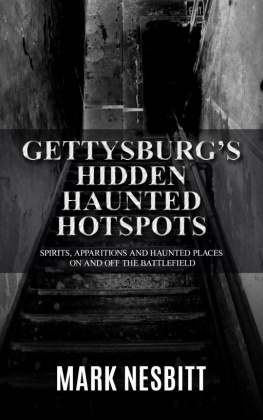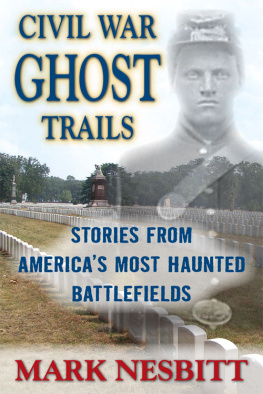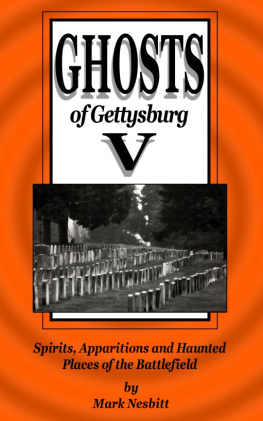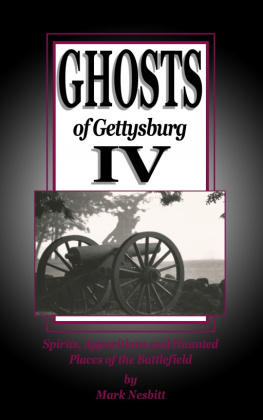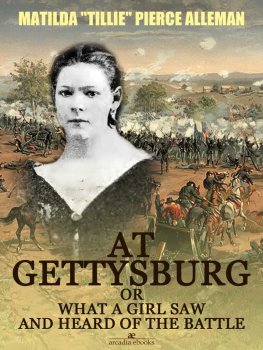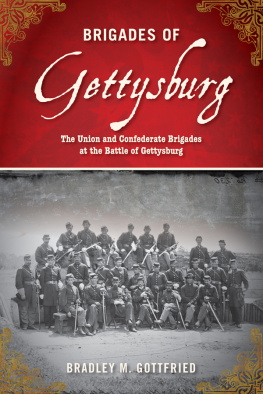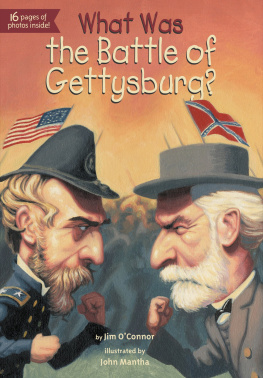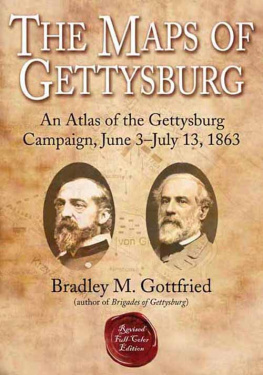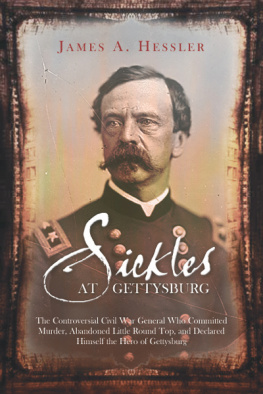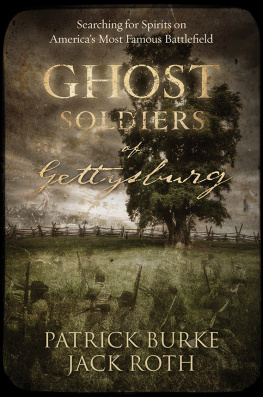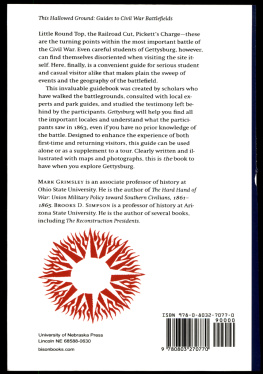Gettysburgs Hidden Haunted Hotspots
Spirits, Apparitions and Haunted Places on and offthe Battlefield
by
Mark Nesbitt
Copyright 2022 Mark Nesbitt
Published by Second Chance Publications
P.O. Box 3126
Gettysburg, PA. 17325
Smashwords Edition, License Notes
WARNING! The stories herein are fully protected by U.S. Federal copyright laws. Unauthorized copying, reproduction,recording, broadcasting, derivative works and public performance,by any individual or company without written consent of thepublisher and author are strictly prohibited. Federal copyrightlaws will be vigorously enforced and infringements will beprosecuted to the fullest extent of the law, which can includedamages and lawyers fees to be paid by the infringer ofcopyright.
ISBN 13: 978-0-9995795-5-8
Photos by Mark and Carol Nesbitt unless otherwisecredited.
Discover other titles by Mark Nesbitt at Smashwords.com
***************
To Luke
From Pop-Pop
***************
Table ofContents
***************
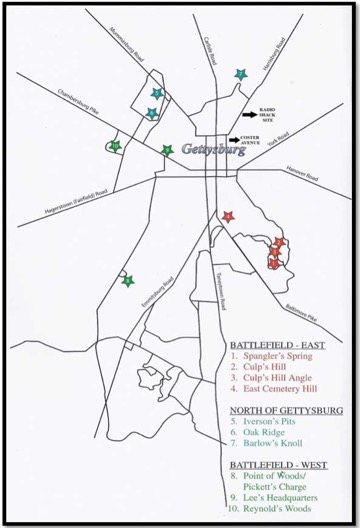
***************
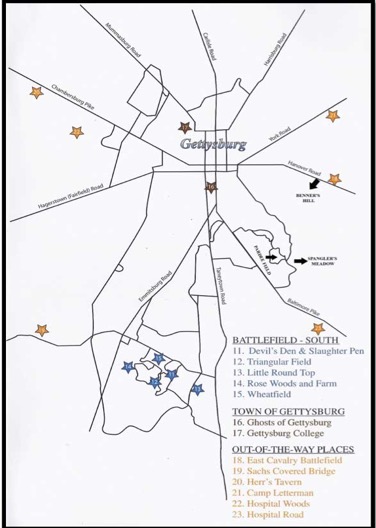
***************
I was asked to speak at a conference and my wifeCarol suggested a topic we had discussed on numerous occasions:Hidden, Haunted, Hotspots of Gettysburg, While the well-knownsites on Gettysburg National Military Park are covered in myGhosts of Gettysburg books, there are other sites, notnecessarily on the park, that are paranormally active as well.
I compiled a list of the obscure sites I knew werehaunted. I researched the history, found or took photos, and pulledtogether (or collected in the field) electronic voice phenomena(EVP) associated with each site.
Unfortunately, my talk was cut short due tounforeseen factors. I had all these sites compiled and still wantedto share this list of obscure but active haunted places. Again,Carol came up with the solution. She suggested a Hidden, Haunted, Hotspots of Gettysburg blog series.
The series was a success. I got a lot of positivecomments about the sites, some of which were completely unknown tomany visitors to Gettysburg. But blogs are fleeting.
Books, however, are not.
It has taken awhile, but Hidden,Haunted, Hotspots of Gettysburg has become a book! Veering frommy normal format of writing about the well-known, often visitedbattle sitesDevils Den, Little Round Top, Seminary and CemeteryRidge, and so forthIve expanded the scope of the ghost stories ofGettysburg to out-of-the-way places, not so familiar to the averagevisitor to the historic area. Since many are quiet, inconspicuousplaces, I also slanted the format to facilitate paranormalinvestigations of the sites, giving suggestions for gatheringevidence, such as EVP.
The fact that there are many sitesof which these arejust a fewassociated with the Battle of Gettysburg that arefar-flung merely indicates that the battle was far larger andcovered so much more ground than you probably realized. The town ofGettysburg, the outskirts of Gettysburg, other towns several milesfrom Gettysburg, were all involved in the fighting that became thegreat battle. As well, places dozens of miles away were all part ofthe great military campaign that culminated in the battle atGettysburg.
If you plan to visit these places, keep in mind thatsome of the sites are on or near private property. In other words,be discrete; dont visit at two in the morning and yell for ghoststo come and talk into your recorder. Also, dont bring large groupsof your closest friends on a ghost hunt to these sites.
A few of the sites are on National Park Serviceproperty, so mind the posted hours of entry.
Enjoy these out-of-the-way places steeped in just asmuch history and hauntings as those places youve heard of in thepanoply of experiences we call Gettysburg.
***************
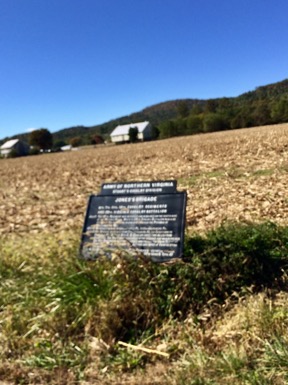
Fairfield Battlefield
Afternoon, July 3, 1863. Gettysburg.
Historians always focus on the Confederate assault onthe center of the Union line on Cemetery Ridge. An entire division,and parts of two other divisions of Longstreets and A. P. HillsCorps of the Confederate Army of Northern Virginia, after atwo-hour artillery duel, began their ill-fated march across nearlya mile of open fields.
The 12,500 Confederates who started the charge areslaughtered: 8,000 killed, wounded or missing in a time span ofjust fifty or so minutes. The assault comes down to us throughhistory as Picketts Charge and becomes a synonym for valorwasted in a lost cause.
But while Picketts Charge gets all the attentionwhen discussing July 3 at Gettysburg, three other smaller, butsignificant battles take place about the same time.
The cavalry battle three miles east of Gettysburg hasgarnered the most attention, probably because it was the largestand involved some of the cavalry stars of the war. Major GeneralJ. E. B. (Jeb) Stuart who commanded the Confederate cavalryduring the battle east of Gettysburg; young Brigadier GeneralGeorge Armstrong Custer (later to sow infamy and reap death duringthe Indian Wars of the 1870s) was one Union officer who opposedhim.
There was also a Union cavalry charge againstConfederate infantry on the south end of the battlefield namedafter its young, martyred leader Brigadier General Elon J.Farnsworth: Farnsworths Charge.
But its the cavalry battle at Fairfield thatqualifies as one of Gettysburgs hidden haunted hotspots.
While Confederate cavalry leader Jeb Stuart gets theunwarranted post-war blame for leaving Robert E. Lee with no eyesor ears during the march northward in June, I believe Isuccessfully defended Stuarts actions in Saber and Scapegoat:Jeb Stuart and the Gettysburg Controversy. Stuart actually leftLee with more cavalry than he had taken with him in hisscout/distraction to the east of the Union army. A brigade underBrigadier General William E. Grumble Jones was one of thoseseveral cavalry units he left directly under Lees command.
An 1848 graduate of the U.S. Military Academy, Jonesserved with Jeb Stuart in the pre-Civil War Indian Wars whereStuart considered him the best outpost officer in the Army. Whenhis bride died tragically in a shipwreck, Jones retired from thearmy and became a virtual hermit on his farm, a changed man. Dour,mean-spirited because of his loss, he received the cognomenGrumble Jones. When the Civil War broke out, he raised a unit ofcavalry and served under Stuart at 1st Manassas.
After the June 9, 1863, Battle of Brandy Stationopened what was to become the Gettysburg Campaign, Jones wasordered to guard the west flank of the invading Confederate Army ofNorthern Virginia while Stuart swung wide to the east, distractingthe northern command and drawing off northern units to seek him outand discover his intentions. Threatening the northern capital,Stuart especially panicked the bureaucrats and military men inWashington worried about their own hides as evidenced by theirdaily panicked communications concerning his whereabouts.
After operations against the railroads in WestVirginia, Jones was recalled by Lee to cross the Potomac andordered to secure the Hagerstown Road at Fairfield, Pennsylvania,on July 3, as a precaution in the event Lee needed a route uponwhich to withdraw his army back to the Shenandoah Valley.
Next page
